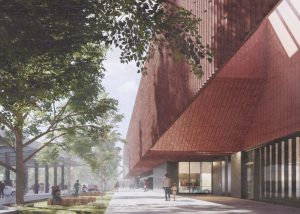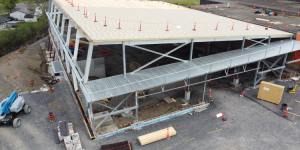There’s plenty of data available on overall construction activity in both the U.S. and Canada, in the form of starts and put-in-place investment figures.
When it comes to the materials going into construction projects, however, the availability of statistics becomes sketchier.
Many firms rely on volume estimates collected and provided by various trade associations.
There is one sub-category of suppliers, however, which does have good representation in government releases. For companies providing heating, ventilation, air conditioning and refrigeration equipment, monthly sales/shipments, new orders, unfilled orders and inventory levels are calculated by both the U.S. Census Bureau and Statistics Canada.
In the U.S., the results can be seen in the Full Report on Manufacturers’ Shipments, Inventories and Orders. (Unfortunately, the shorter and better-known Advance Report on Durable Goods Manufacturers’ Shipments, Inventories and Orders disaggregates only to the ‘machinery’ level, without stepping down one more rung to the HVAC category.)
For any given month, there’s usually about a two-week gap between the advance report and the full report.
In Canada, the Monthly Survey of Manufacturing report also fails to deliver the desired level of detail. Its degree of refinement also stops at ‘machinery’.
One can easily go online, however, to Statistics Canada’s Cansim database and look up HVAC manufacturers in Table 304-0014. (By the way, in case you’re interested, or need to do further research, the HVAC sector’s North American Industrial Classification System (NAICS) number is 3334.)
The U.S. data is available both seasonally adjusted (SA) and not seasonally adjusted (NSA). Only NSA data can be assessed for Canada.
To be consistent, this article will feature NSA data for both countries. Besides, there’s an easy way to remove the seasonality problem with NSA data, use 12-month moving totals or averages.
Total sales by HVAC manufacturers in the U.S. in 2014 reached nearly $45 billion (in U.S. funds), according to CMD’s estimate. North of the border, they approached $3 billion in ‘loonies’ (i.e., Canada’s currency).
Therefore, the combined market in the U.S. and Canada almost touched $50 billion last year.
In the U.S., the latest (November 2014) 12-month moving total sales/shipment figure was +1.7% versus the prior 12 months. New orders were better, at +5.4%.
As for unfilled orders, the 12-month moving average volume was +19.5% year over year. The standalone month of November 2014 was an impressive +30.7% compared with November of 2013.
In Canada, October’s 12-month moving total sales/shipment figure was +10.4%, while new orders were +17.5%.
Canada’s 12-month moving average unfilled orders level in October 2014 was +12.3% when compared with October 2013. The standalone month of October was up to a similar degree as in the U.S., +34.2%, or one-third higher.
The percentage changes set out in the foregoing, combined with the upward slopes of the graphs that accompany this article, highlight clearly that HVAC is an industry sector with generally improving prospects.
In what follows, I’ll set out the trends that will impact the activity levels of HVAC manufacturers in the year or two ahead. For starters, though, let’s get the exchange rate issue out of the way.
The U.S. economy is performing best among the world’s major developed and emerging nations. A notably visible result has been a surge in the value of the U.S. dollar. The more expensive ‘greenback’ places a handicap on U.S. domestic HVAC producers. The prices of their goods selling into foreign markets are becoming less competitive. At the same time, offshore competitors seeking customers in the U.S. are benefitting from a currency-induced reduction in import prices.
With that far-from-insignificant caveat, U.S. producers of HVAC equipment should be optimistic about their potential over the next couple of years.
Not only will they be seeing an ongoing cyclical improvement in construction, but there are trends within the various types-of-structure that will give them a boost as well.
Beginning with the residential construction market, the biggest-ticket HVAC sales items (furnaces, cooling units, etc.) are in high-rise structures.
This is fortuitous for the industry, since societal and demographic trends are pointing to stronger multi-unit residential construction starts relative to the single-family market segment.
The 2008-09 recession, with its accompanying tidal wave of foreclosures, has rendered many individuals and families leery about undertaking a new single-family home purchase.
Better to keep on renting, so the thinking goes, and that generally means extra demand for units in high-rise buildings.
Or even if ownership is still viewed as desirable, a condominium offers a cheaper entry-level option compared with a bungalow and plot of land in the suburbs.
Aging baby boomers are discovering the joys of high-rise living downtown. Leave the car in the underground parking garage and walk or take a cab-ride to shopping, dining, the theatre or a medical appointment.
Young adults, gaining their first job experience, also appreciate residences in the midst of the entertainment ‘scene’ in the downtown core.
Urban crime used to act as a deterrent to this lifestyle. With law and order crackdowns, city centers have become safer places to visit and inhabit.
As part of high-rise living, there has been a proliferation of mixed-use projects, especially in proximity to rapid transit stations.
Mixed-use projects include residential, office, retail, medical and accommodation (e.g., hotel) space. As for the latter, ‘leisure and hospitality’ has been one of the sub-categories of U.S. employment experiencing the most rapid build-up of hiring over the past couple of years. The year-over-year percentage change in jobs has consistently been close to +4.0%, compared with a total-economy rate of increase that has struggled to reach +2.0%.
Mixed-use projects and rapid transit, side-by-side or on top of each other, define the term synergy. The second brings traffic to the first; the first assures ridership for the second.
Politicians generally love rapid transit projects. They’re a highly visible means to impress voters with the efforts being made on their behalf.
Rapid transit is also an easy pitch based on its cleaner environment connotations. Clusters of development that incorporate the live-work ideal, while reducing the carbon footprint from vehicular traffic, is a winning ‘green’ strategy for municipal planners.
Greater office and residential tower construction is being planned in some of the nation’s biggest cities, including New York (Hudson Yards), Tampa (Channel District) and Miami (the Worldcenter Development).
Forward thinking companies in the high-tech sector are providing their work forces with attractive campus-like locations where they can both live and work (e.g., Amazon in downtown Seattle; Apple in Cupertino California.)
Not to forget our major topic area, all of these projects will need state-of-the-art heating, cooling and ventilating systems.
The retail sector also appears on the verge of a new wave of construction. The dramatic decline in the price of gasoline is freeing up money that consumers can spend on other goods and services.
While the Internet is taking away some ‘bricks and mortar’ construction, there is the impression that online retail sales may top out between 12.0% and 15.0% of the total. The progression from 0.0% to 7.0% happened quickly; from 7.0% to a current 9.0%, has been slower.
All ‘serious’ retailers must have an Internet presence. Shoppers are making purchases on-line, no doubt about it, but just as often, they’re using their browsers to conduct research about what products are available; and which vendors have the sought-after good in stock; and how do their prices stack up against each other? Then they go to the store of their choice and take out their wallets or purses, or flash a credit or debit card.
The physical act of shopping will never disappear. For a vast majority of people, it’s a recreational activity. It’s what gets them out of the house on the weekend.
Before leaving the commercial construction marketplace, HVAC manufacturers should also make note of the large number of stadium and arena projects planned across the nation by teams in the NFL, NBA, NHL and major league baseball. Contract awards from these projects will be major revenue generators.
In the institutional category of construction, aging baby boomers guarantee work in the hospital/medical field will be strong for decades to come; at least, once the virtual moratorium on projects, due to uncertainty surrounding the introduction of Obamacare, comes to an end.
Increases in school enrolments will mainly be driven by the grandchildren of the baby boomers out to the 2020s. There will be more work at the level of elementary and secondary schools.
Colleges will receive a boost, if President Obama realizes his wish to make attendance free. He’ll need the backing of Congress, however, and partisanship makes that unlikely.
Construction at universities will largely arise due to the generosity of former students. Successful alumni sometimes like to shower their alma maters with financial gifts. The process is helped along when their names are attached to new faculty buildings by ready-to-please administrators.
Manufacturing plant construction will benefit from a repatriation of jobs. In some overseas countries, there have been multifold increases in the cost of labor and/or the introduction of new workplace rules to bring health and safety standards closer in line with richer nations.
Low-cost energy – realized from the hydraulic fracturing of shale-rock – is providing U.S. manufacturers with an advantage. CMD’s industrial starts in 2014 were +16.5% versus 2013. A further significant increase in ‘current dollar’ (i.e., not adjusted for inflation) industrial construction is expected in 2015.
There’s one final chapter, with an expected big impact on HVAC firms, to be discussed − the relationship between the environment and technology. It would be easy to assume the drop in the global price of oil will curb the world’s shift to greater fuel efficiency.
Neither the technology wizards who are devoting their working lives to the cause of energy efficiency nor the environmental activists for whom this is their ‘calling’ are likely to let that happen.
It has long been known that carbon emissions from buildings are as pervasive − if not more so − as those from the tail pipes of motor vehicles traveling the nation’s roads and freeways. HVAC manufacturers will continue to face scrutiny over whether they are doing enough to purify the air we all breathe.
The flip side will be greater opportunities to promote the sales of those products that do extend building life cycles, especially if they also lower maintenance costs.
A number of high-profile ‘net-zero energy’, or ‘carbon neutral’, or so-called ‘passive’ structures have already been built. The construction industry can be assured that HVAC companies will be taking pride in their efforts to innovate further.










Recent Comments
comments for this post are closed